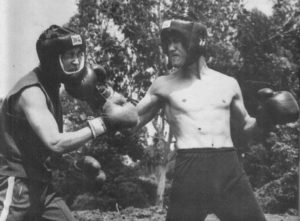
We are all fully aware of how demanding boxing is on the body. So much so that ESPN suggests it’s probably the toughest sport to compete in. The amount of effort, skill, and dedication that it demands from its boxers is second to none—not even football, baseball, or basketball—which is why the sport’s greatest earn a tremendous amount of respect from all over the world.
Boxing is one of the oldest combat disciplines, having been developed and improved for more than a millennium. Dubbed as “the sweet science,” it is a discipline that is continuously being crafted and perfected with each fight, before the eyes of roaring crowds. All this and more makes boxing one of the biggest influences on one of the men who shaped the way we understand fighting today: Bruce Lee.
The impact of Lee’s short but rich career is still felt today, more than four decades after his death. Countless books have been written about him, and he has left behind a body of work in film that continues to inspire fighters young and old. Even video games that people can play anywhere contribute to spreading his legacy, with digital gaming platform Slingo releasing the über trendy Bruce Lee slot game. The Chinese star is featured in an array of poses in the game, illustrating how he combined fighting styles that are both traditional and modern, as well as oriental and western.
The phrase “be like water,” as he’s widely known to have said, articulates the attitude that he has carried with him throughout his life. Among the incredible things that he accomplished in his 33 short years was developing Jeet Kune Do, a fighting discipline that exhibits both of Lee’s respect for traditional martial arts traditions in the east and his openness to the innovations and discoveries of fighting practices in the west. Without much surprise, one of these western disciplines was boxing. Dan Inosanto, Lee’s training partner, reveals that while “most people aren’t aware of it, Bruce Lee was very into boxing—scientific boxing”.
Boxing online news website ESNews posted a YouTube video in which Leo Fong, a Golden Gloves boxer who was also one of the guys that Lee has trained with, shares with fond recollection the role that boxing had played in turning Lee into the star he would later become. When Lee arrived from China, Fong says, he came with a stance developed through the Chinese discipline Wing Chun from which he hasn’t yet evolved much from. His stance was upright and his attacks came head-on; all it took was Fong’s stepping aside, followed by a good left hook to change Lee’s style forever. To Lee, this was nothing short of an epiphany.
Fong demonstrated a feature of Western fighting style that Bruce Lee hadn’t until then paid much attention to. Lee would go on to amass a huge library of books and videos, a lot of which were boxing references from real matches. He would gather friends on Wednesdays for marathon viewings of them, and show an infinite amount of interest in the sport’s nuances in order to learn as much as he could from it.
It was this dogged determination, combined of course with all the skills that he has learned from other disciplines before his move to America (including Cha Cha!), that has enabled him to transcend and improve upon his kung fu training, in the process developing Jeet Kune Do.
Bruce Lee would have been 77-years-old today, had he not passed away at the young age of 33. His followers went towards different directions after his death, all inspired and guided by his teachings and training. We would never know how his discipline would have evolved under his watch.
What we do know is that one of the disciplines that have formed the foundation of his, the sweet science of boxing, would continue to transform along with every fighter, and evolve through each fight.

Just a minor correction, Bruce Lee was born in San Francisco then moved to Hong Kong (a British colony at the time and not part of China) before returning to the states.